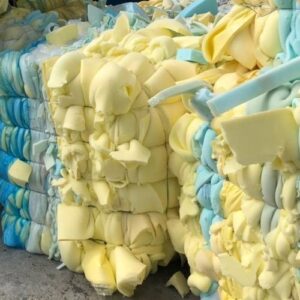PU Foam Scrap Uses
PU Foam Scrap Uses: Sustainable Solutions and Creative Applications
Introduction:
Polyurethane (PU) foam scrap, often considered waste in manufacturing processes, possesses untapped potential for diverse applications. This article delves into the myriad uses of PU foam scrap, shedding light on its sustainable attributes and creative reimagining across industries.
Understanding Polyurethane Foam Scrap:
PU foam scrap originates from the production of polyurethane foam products. In its original form, polyurethane foam is used as a cushioning material in furniture, bedding, and numerous packaging applications across industries. The manufacturing process normally generates small particles known as scraps or excess material, which is used as primary material in other industries.

- Furniture and Bedding Industry:
- Cushion Filling: PU foam scrap finds its primary reuse in the furniture industry as filling material for cushions and pillows. The shredded or granulated form of scrap provides a cost-effective and eco-friendly alternative to traditional fillers.
- Mattress Production: Incorporating PU foam scrap into mattress manufacturing contributes to both comfort and sustainability. By utilizing scrap material, manufacturers reduce waste and offer a greener option to consumers.
- Automotive Sector:
- Sound Insulation: PU foam scrap proves effective in automotive applications, particularly for sound insulation. The material’s acoustic properties make it an ideal choice for reducing noise and enhancing the comfort of vehicle interiors.
- Seat Cushioning: In the automotive seating industry, PU foam scrap can be repurposed for cushioning components. This not only lowers production costs but also minimizes the environmental impact of discarded foam.
- Building and Construction:
- Insulation Panels: PU foam scrap can be transformed into insulation panels for buildings. The material’s thermal insulation properties contribute to energy efficiency, offering an eco-friendly alternative to traditional insulation materials.
- Construction Fillers: In construction projects, granulated PU foam scrap serves as lightweight fillers. This reduces the overall weight of structures while providing insulation and sound absorption.
- Arts and Crafts:
- Creative Reuse: PU foam scrap can inspire artistic endeavors. Crafters and artists repurpose scrap material for various projects, such as sculptures, props, and DIY home decor. Its malleability and lightweight nature make it an appealing choice for creative expressions.
- Toy Manufacturing:
- Stuffed Toys: The soft and pliable nature of PU foam scrap makes it an excellent material for stuffed toys. Manufacturers can utilize scrap to create plush toys, contributing to both sustainability and cost-effectiveness.
Sustainable Benefits of Utilizing PU Foam Scrap:
- Waste Reduction: Incorporating PU foam scrap into manufacturing processes reduces the amount of waste sent to landfills. This aligns with the principles of a circular economy, where materials are reused and repurposed, minimizing environmental impact.
- Resource Conservation: By reusing PU foam scrap, industries decrease their reliance on virgin materials. This conservation of resources contributes to a more sustainable and responsible approach to production.
- Energy Efficiency: The energy required to recycle and process PU foam scrap is often lower than that needed for manufacturing new foam products from raw materials. This energy efficiency further supports the environmental sustainability of utilizing scrap.
- Cost Savings: Utilizing PU foam scrap as a raw material can lead to cost savings in production. This is especially advantageous for industries seeking economical solutions without compromising quality.
Challenges and Considerations:
While the uses of PU foam scrap are diverse and promising, it is essential to address challenges and considerations associated with its implementation:
- Quality Control: Maintaining consistent quality when using recycled PU foam scrap is crucial. Industries must implement stringent quality control measures to ensure the performance and durability of products.
- Chemical Composition: PU foam scrap may contain additives and chemicals from its original manufacturing process. Understanding and addressing the chemical composition of the scrap is vital, especially in applications where consumer safety is a concern.
- Collection and Sorting: Efficient collection and sorting of PU foam scrap from various sources pose logistical challenges. Establishing streamlined processes for the collection and separation of scrap is essential for effective recycling.
- Market Awareness: Creating awareness about the benefits and potential uses of PU foam scrap is crucial. Industries and consumers need to be informed about the sustainable advantages and applications to drive increased adoption.
Conclusion:
The versatility of PU foam scrap extends far beyond its traditional role as manufacturing waste. From enhancing the comfort of furniture and bedding to contributing to sustainable building practices, the creative applications of PU foam scrap are diverse and impactful. Embracing the reuse of PU foam scrap not only addresses environmental concerns associated with waste but also presents economic advantages and supports the shift towards a circular economy. As industries continue to explore innovative solutions for a sustainable future, PU foam scrap stands as a valuable resource ready to be reimagined across various sectors.
